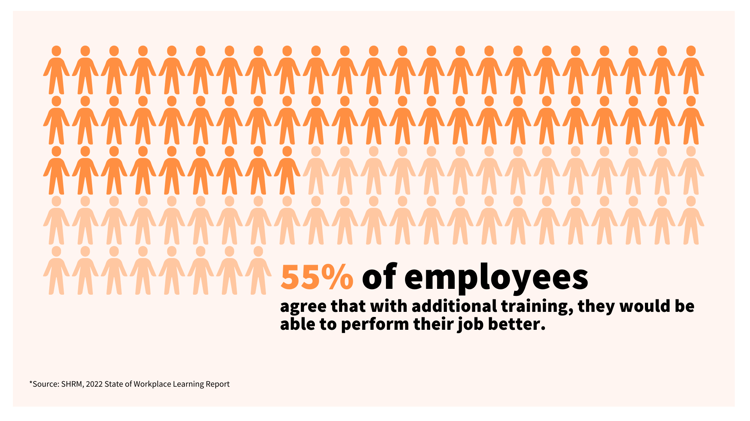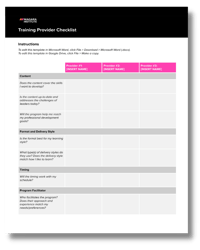5 min read
What Is a Training Needs Assessment? (+Template)
If you’re reading this article, you either know for certain or have a hunch that someone you know needs training. You’ve likely noticed that they’re...
4 min read
 Michelle Bennett
:
Oct 26, 2023 5:00:00 AM
Michelle Bennett
:
Oct 26, 2023 5:00:00 AM

It’s no secret investing in employee training can reap big rewards. From increased productivity and engagement to fewer errors and rework, the better-equipped employees are, the more likely they will be able to contribute to achieving the goals and mandates of your team and organization.
Despite this, the road to securing a training budget is often riddled with challenges and roadblocks. Convincing stakeholders of the immense value and return on investment that training programs offer requires a well-crafted strategy and creating a compelling case that speaks to their goals and concerns. To make the process as simple as possible, in this article, we will explore strategies to present a compelling case for employee training and development and provide you with a training budget request letter template to get started.
There is immense value in investing in employee training and development, and these statistics from SHRM’s 2022 State of Workplace Learning Report highlight just that. Use some (or all) of these statistics when building a case for training for your team.
76% of employees would be more inclined to stay at their current employer if they offered continuous training and development.
.png?width=750&height=422&name=Employee%20Retention%20Statistics%20-%2076%25%20of%20employees%20would%20be%20more%20inclined%20to%20stay%20at%20their%20current%20employer%20if%20they%20offered%20continuous%20training%20and%20development.%20%20%20(1).png)
83% of HR managers agree that offering employee training and development is critical to attracting talent. Meanwhile, 46% of employees agree that they considered the training and development opportunities when choosing their current employer.
.png?width=750&height=422&name=Attracting%20Talent%20Statistics%20(1).png)
53% of HR managers agree they have a skills gap in their organization, and 51% believe that employee training and development is the best way to close a skill gap.
.png?width=750&height=422&name=Closing%20Skill%20Gaps%20Statistics%20(1).png)
The majority of employees (55%) agree that with additional training, they would be able to perform their jobs better.

A well-thought-out plan makes all the difference in securing an employee training budget. Here are several strategies to create a training plan and budget that gets approved.
What are your company's strategic directions, goals, and vision? Aligning your training request with how it will support your organization’s strategic objectives is crucial to getting a training budget approved. When putting together your proposal, you’ll want to clearly articulate and draw a line to how the training will contribute to achieving key performance indicators and business goals for your company.
.png?width=300&height=250&name=Free%20Training%20Needs%20Assessment%20Success%20Kit%20(1).png) Now that you’re equipped with a clear understanding of your company’s strategic initiatives, goals, and vision, the following strategy is to conduct a thorough employee training and development needs analysis to identify specific skill gaps, performance, challenges, and development opportunities within your team. We’ve made this easy with the Training Needs Assessment Success Kit. Within it, you’ll find the templates you need to:
Now that you’re equipped with a clear understanding of your company’s strategic initiatives, goals, and vision, the following strategy is to conduct a thorough employee training and development needs analysis to identify specific skill gaps, performance, challenges, and development opportunities within your team. We’ve made this easy with the Training Needs Assessment Success Kit. Within it, you’ll find the templates you need to:
To create a training budget and understand the training costs, you’ll want to conduct thorough research to identify relevant and reputable training providers or programs that meet your competency development needs. You’ll want to explore the learning methodology (lectures, case studies, simulations, etc.), how the learning is delivered (live facilitator or video learning), the training content (the learning outcomes/what the training covers), if it includes and accreditations or certificates, participant evaluations, and participant testimonials and or client testimonials. To help you keep track of the different training options and how they stack up against each other, use the Training Provider Checklist, which can be found within the Training Needs Assessment Success Kit. Here, you’ll have a spreadsheet that tracks these critical areas, with prompts for questions to ask each provider.
To help you keep track of the different training options and how they stack up against each other, use the Training Provider Checklist, which can be found within the Training Needs Assessment Success Kit. Here, you’ll have a spreadsheet that tracks these critical areas, with prompts for questions to ask each provider.
As a benchmark to see if your training budget is realistic, the 2022 State of the Workplace Learning and Development Report found the majority of learning and development spend per employee falls into these categories:
Now that you have all the information you need, it is time to assemble a comprehensive training plan and budget to present to your key stakeholders. To help you track and summarize all the critical information, complete the Needs Assessment Template, which can be found in the Training Needs Assessment Success Kit.
The information summarized in the Needs Assessment Template will be the foundation to build your compelling training budget request letter and to provide supporting documentation in your email.
By incorporating the above strategies into your training budget request letter, you'll be better positioned to present a compelling case. Remember to adapt these strategies and your letter to your unique team and organizational context to ensure maximum impact.
Dear [First Name],
I’m reaching out today as I see a real opportunity for my team to help [Company name] achieve [Strategic initiative/goal] by investing in their development.
While there is a cost associated with providing training, I believe the organization will see an ROI from this investment in the form of an increase in [Explain how the training will help the company achieve its goals] and/or a reduction in [How the training will stop certain outcomes/behaviors]. In addition to goal achievement and financial benefits, this investment will help retain these employees, who often ask for development opportunities.
I have thoroughly analyzed the team's skillsets today against what is needed to support where the company wants to go and respond to changes in the marketplace and our functional area. From there, I evaluated each individual to determine the training they required. As you will find in the attached training plan and budget, I have researched and selected the optimal training programs and created a budget.
The budget I seek for the training is [Price], which works out to [Price] per employee.
I would be pleased to meet to go over my analysis and discuss in more detail the impact [Company name] can expect from this investment in training.
Thank you for your consideration. I look forward to hearing from you.
[Name]

5 min read
If you’re reading this article, you either know for certain or have a hunch that someone you know needs training. You’ve likely noticed that they’re...

7 min read
60% of new managers fail within their first 24 months. Let that sink in. More than half of new managers will be unsuccessful, and the consequences of...

4 min read
It can be a nerve-wracking and intimidating experience to ask your employer for approval and funding for professional development activities like ...